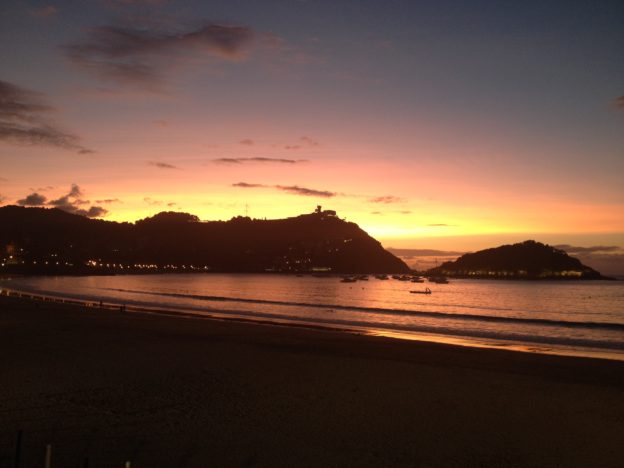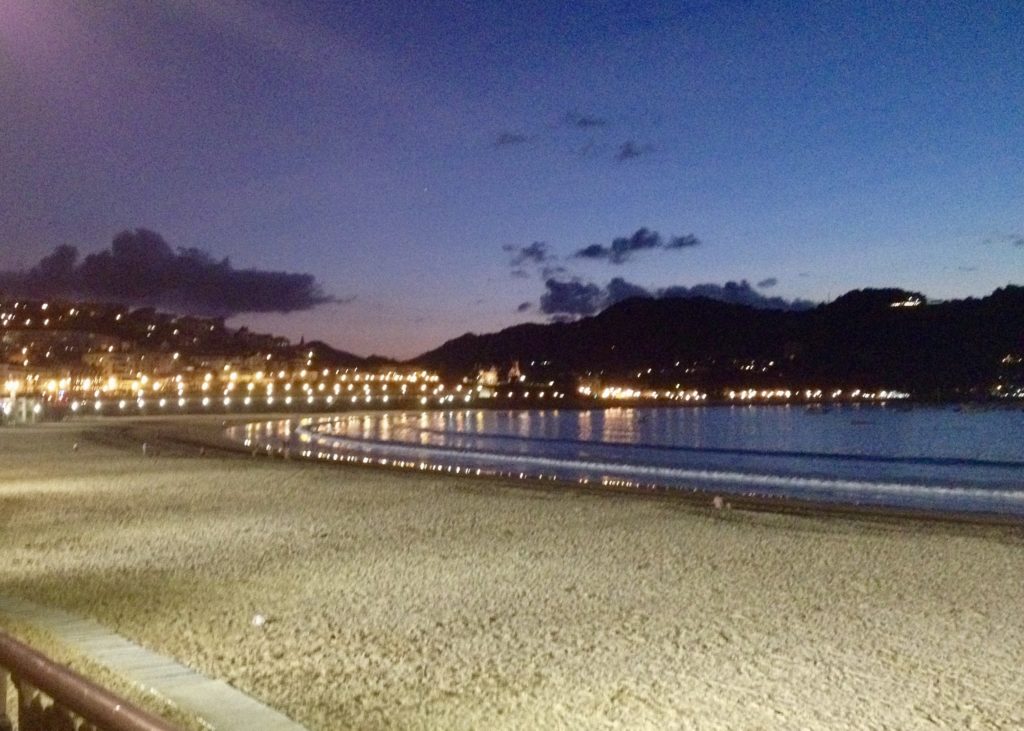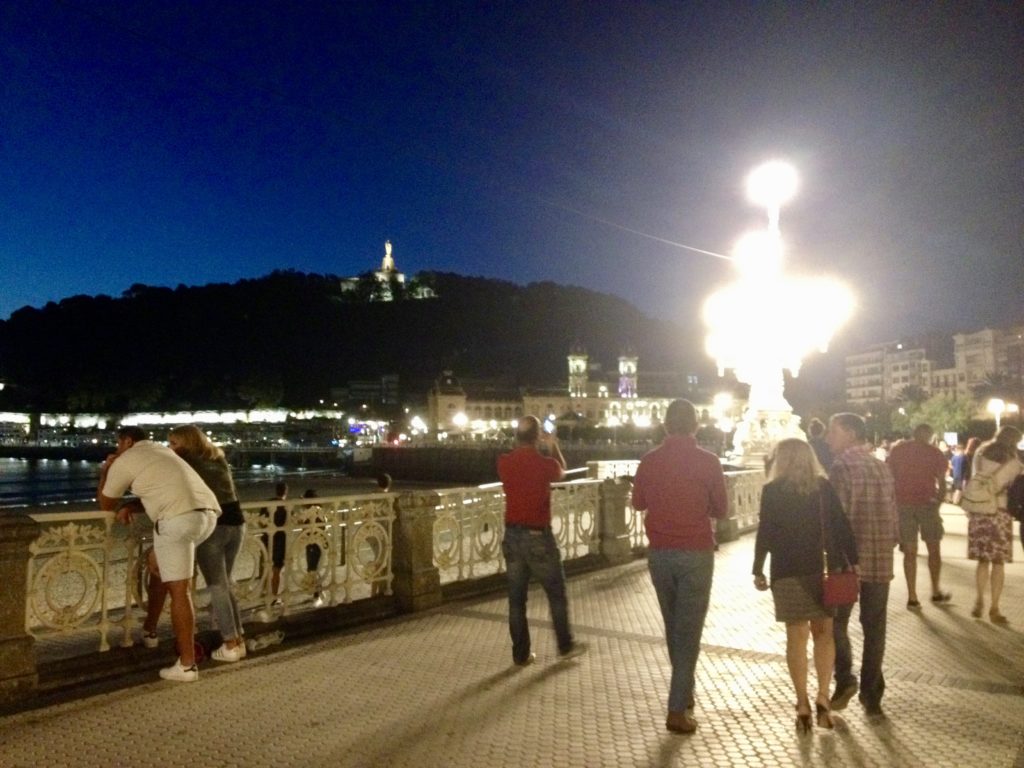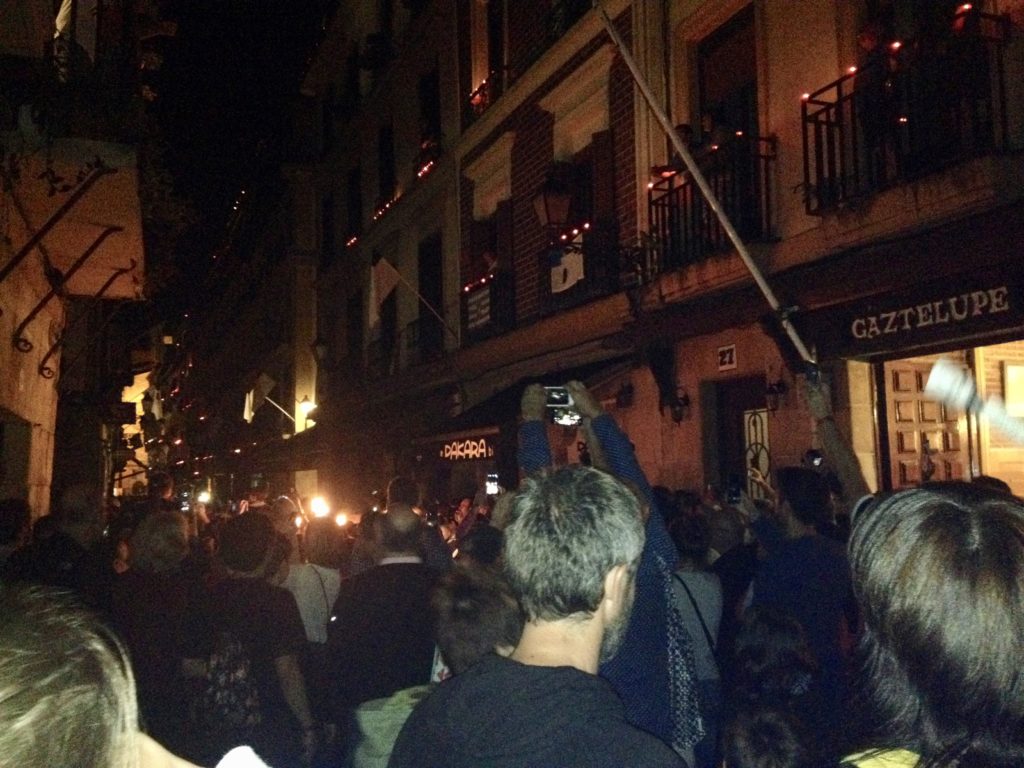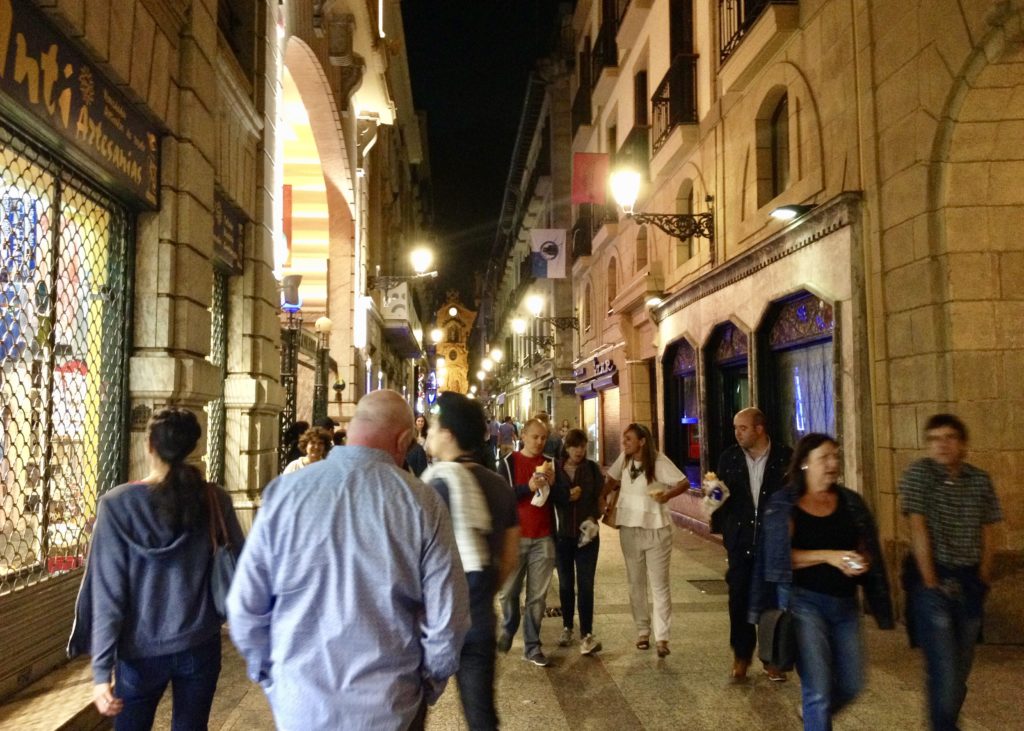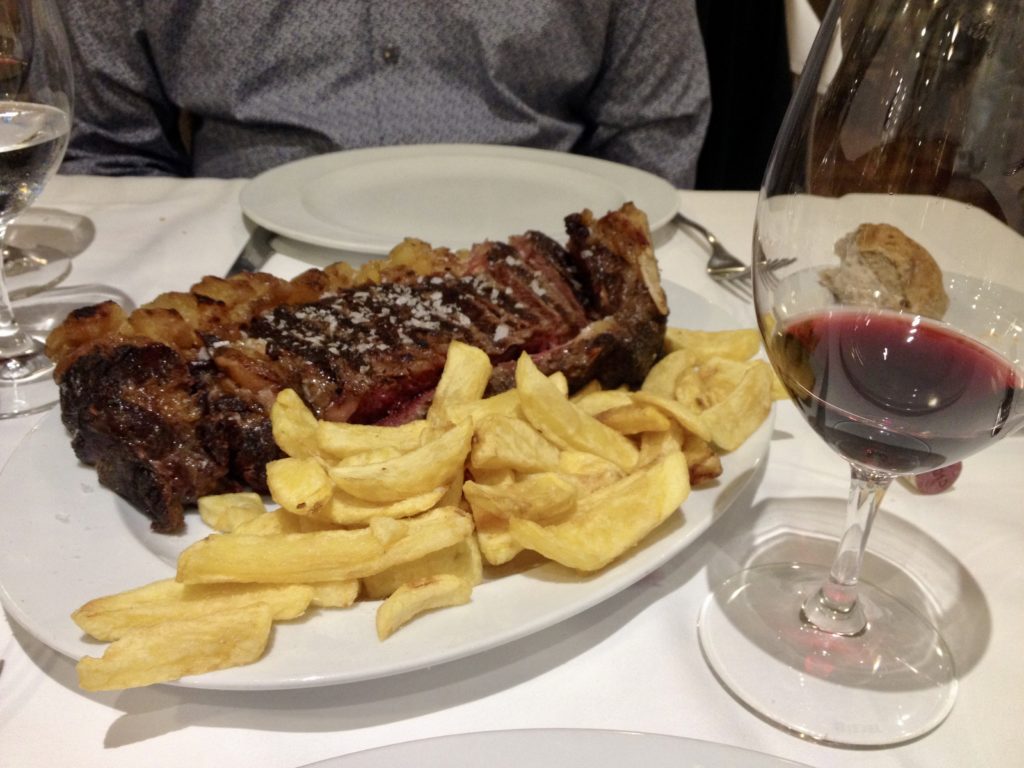by Wendy
It’s evening in San Sebastian/Donostia and we are going for a walk. We join locals and fellow visitors strolling the long stretch of boardwalk that follows the curve of the beautiful coastline. We’re on our way to have dinner in Old Town.
There is the beach where we spent a relaxing afternoon, reading and braving the icy cold water. A few people are still wading in the waves. The sailboats float in the distance on the shimmery sea. There is a group playing a hybrid game of soccer/volleyball on the sand, dexterously heading or kicking the ball over a net.
We stop for a drink in one of those places with terraces overlooking the shore. It’s probably touristy and the waitstaff kind of snotty – but who cares when the view of the sunset is that good.
We continue strolling, people watching and sunset watching. Everyone seems drawn to the boardwalk, the beach, the city streets, the restaurant scene, whether young or older or in a baby stroller or walking or in a wheelchair.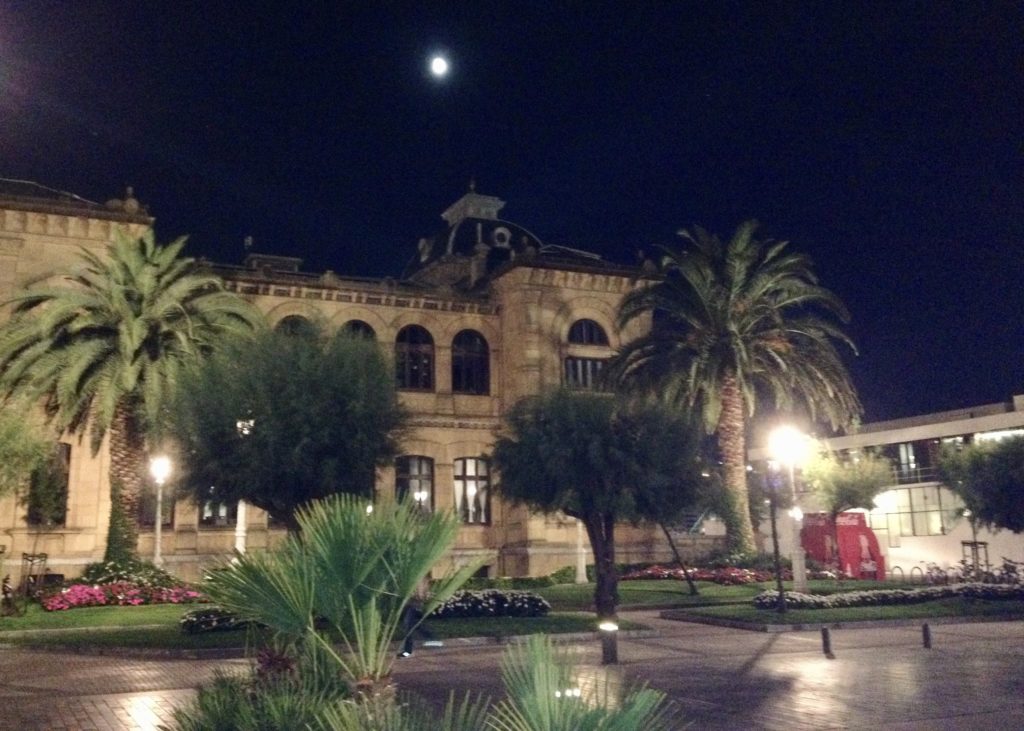
As we get closer to Old Town it’s growing crowded – more than we expected. We slowly make our way through narrow streets packed shoulder to shoulder. There is a stage, but nothing happening. There is an air of expectation. We move forward a block or so. Now the streets are dark, except for tiny orange lights on balconies.
We have no idea what this is about. We decide to stand with everyone and see what’s going to happen.
There is noise in the distance – it appears a procession is on the way. Awesome! Have we stumbled upon a Spanish festival? People are craning necks to see. Some have phones poised to take a photo, while other phones have been confiscated by kids sitting on the sidewalk playing games.
A phalanx of musicians is walking down the center of the cramped street. The crowd grows quiet and gives them space, barely. Some in the procession look like they are wearing traditional costumes and some are carrying oars. There is music, then a song. We can barely see, but join in the clapping. They pass and spectators begin to move. We look a bit longer at the eerie yet beautiful streets shining with orange lights.
The crowd is ready to party on. We pass one packed restaurant after another with plenty of spillover outdoors, people standing at tables decorated with empty wine glasses and full ash trays, others sitting on the curbs balancing plates on their knees while talking animatedly with friends. It’s well after 10pm and definitely time for dinner.
We pop in one place we’ve read about and are thrilled to be escorted to a table – until less than 1 minute after we sit down, the waitress returns, apologizing profusely that the couple who made reservations have arrived but we could still order food at the bar. We understand, but decide to find somewhere else. We secure a seat at another place that looks promising with its array of pintxos on the counter, but a clique of drunk tourists is intent on spoiling it for everyone. We leave. San Sebastian is noted for its number of Michelin star restaurants; we try our luck at one but are not surprised when the sympathetic hostess says they’re booked. We stop in a couple other places, but frazzled, tired staff informs us they’ve just completed dinner service. Now we’re starting to worry – people in Spain eat late and if restaurants are closing, it’s getting really late.
We walk in Gandarias. It’s just as hectic as anywhere, so we aren’t hopeful as we track down the host. He’s cheerful and not bothered by the crowds in the least. Sure, he tells us, you can have a table at 11:30 or 11:45. We hesitate briefly and then accept gratefully. “I’ll take your name and find you.” he reassures.
“Thank you. It’s Jack,” says Jack.
“Easy to remember,” our charmer host grins.
Jack and I go to the bar, a little shellshocked by the evening. We check our cash situation and see we’ve got a 10 euro bill and some change. We decide to save the 10 euros in case we want to take a taxi back to the hotel. Who knows how late it will be when we finish dinner? But it’s Spain, so a couple euros in change is usually enough for two glasses of vino.
After about 20 minutes we are escorted to a table. The waitress is as welcoming as the host and answers our questions about the occasion, explaining that the event is held every August 31 to remember an 1813 battle and commemorate those who rebuilt the city after fire and destruction.
It’s still lively in the dining room, with a warm atmosphere. A stylish French couple to the left, a big group behind us (with one or two who look like they were part of the procession) and a family to the right. Yes, it’s almost midnight and a couple of kids are finishing dinner and behaving without batting an eyelash. Not sure if it’s a typical occurrence for a Thursday, or if they get to stay up late because it’s August 31.
It feels great to sit down and the bottle of exquisite Rioja perks us up even more. We order peppers stuffed with crab to start, soaking up the delicious sauce with fresh bread. We share a porterhouse steak, one of Gandarias’ specialities. Cooked perfectly on the rare side with flavorful salt rub, tender and juicy. Served with crispy golden fries. A steak eaten around 1am after a Basque festival might be more delicious than a steak eaten at 12pm or 5pm or 9pm.
To top it off the bill is incredibly reasonable, a little over $100. While service is included in Spain, we often leave a bit extra. Especially in a place like this, when we were accommodated on such a busy night. We leave the 10 euro bill and walk along the boardwalk across from the calm ocean in the beautiful early early morning dark back to our hotel.
